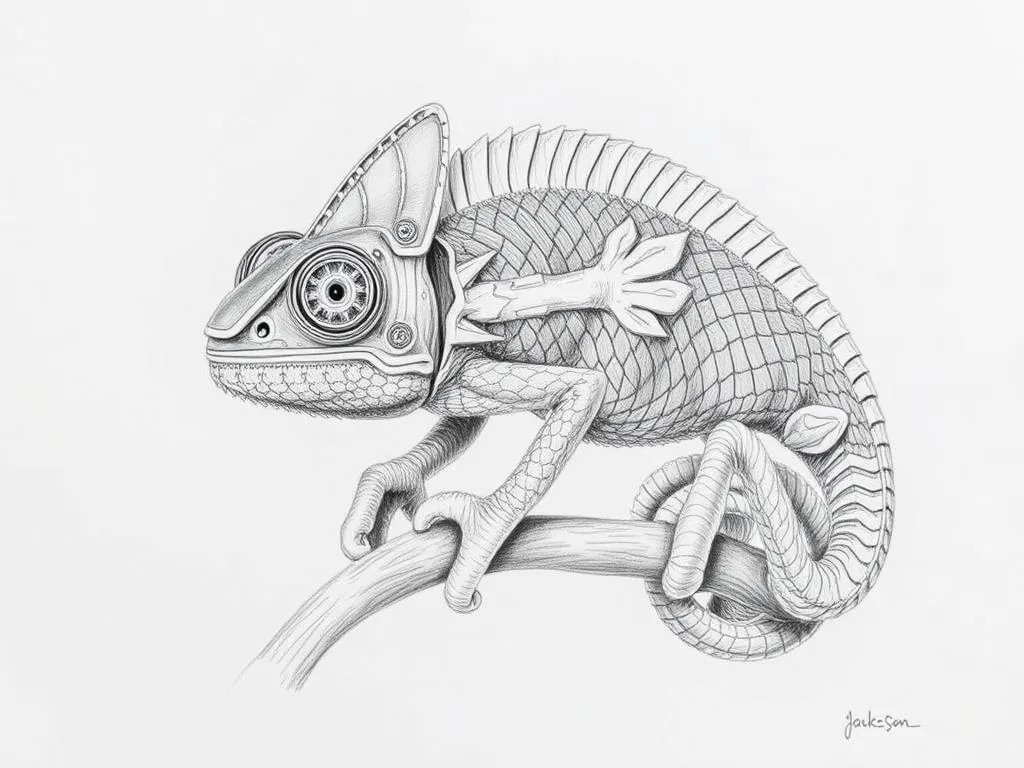The Enigmatic Symbolism of the Jackson’s Chameleon

Disclaimer: Some images on this website are AI-generated artworks and may not accurately represent real animals.
The Jackson’s chameleon is not just a fascinating reptile; it embodies a rich tapestry of symbolism and meaning that resonates deeply with those who seek understanding in their lives. This blog post delves into the various dimensions of the Jackson’s chameleon symbolism and meaning, shedding light on its physical characteristics, behavior, and the deeper spiritual insights it offers.
Understanding the Jackson’s Chameleon
Physical Characteristics
The Jackson’s chameleon (Trioceros jacksonii) is renowned for its striking appearance. Below is a table summarizing its unique features:
| Feature | Description |
|---|---|
| Color-Changing Ability | Can change colors based on mood, temperature, and environment. |
| Horns | Males possess three prominent horns resembling those of a unicorn. |
| Body Shape | Distinctive, with a laterally compressed body and a prehensile tail for climbing. |
| Size | Typically ranges from 10 to 15 inches in length. |
| Skin Texture | Rough, scaly skin that enhances its camouflage abilities. |
These characteristics not only make the Jackson’s chameleon visually captivating but also serve practical purposes in its survival.
Habitat and Behavior
The Jackson’s chameleon thrives in the lush forests of East Africa, particularly in Kenya and Tanzania. Preferring humid, arboreal environments, these chameleons are often found in trees and shrubs. Their diet consists mainly of insects, but they also consume leaves and fruits, showcasing their omnivorous tendencies.
In terms of social behavior, Jackson’s chameleons are generally solitary creatures. Males are known to be territorial, often displaying their vibrant colors to ward off rivals. Their unique ability to blend into their surroundings aids in both hunting and avoiding predators, making them fascinating subjects of study in the animal kingdom.
Cultural Significance
The Jackson’s chameleon plays a vital role in the ecosystem, contributing to biodiversity and the health of its habitat. As insectivores, they help control insect populations, promoting a balanced ecosystem. Culturally, these chameleons have become symbols of transformation and adaptability, which aligns with their incredible ability to change colors. This connection to nature and balance underscores their cultural significance across various societies.

Symbolism & Spiritual Meaning
Adaptability and Change
One of the most profound aspects of the Jackson’s chameleon symbolism and meaning is its representation of adaptability and change. The chameleon’s ability to alter its color serves as a powerful metaphor for life’s transformations. Just as the chameleon shifts hues to blend into its environment, individuals can learn to navigate the ever-changing landscape of life.
In times of uncertainty, embracing change can lead to personal growth and resilience. The Jackson’s chameleon encourages us to remain flexible, reminding us that transformation is not only necessary but also a vital part of our journey.
Observation and Patience
The Jackson’s chameleon is a master of observation. Its keen eyesight and ability to remain still for extended periods symbolize the virtues of patience and awareness. When we take the time to observe our surroundings, we gain insights that can lead to deeper understanding and connection with ourselves and others.
This symbolism highlights the importance of mindfulness in our daily lives. By practicing patience and keen observation, we can make more informed decisions and foster stronger relationships.
Self-Expression and Identity
The vibrant colors of the Jackson’s chameleon are not just for camouflage; they also serve as a means of communication and self-expression. Each hue can convey different emotions or intentions, paralleling the human experience of expressing identity through various forms.
The chameleon encourages us to embrace our unique qualities and express our true selves authentically. In a world where conformity often reigns, the Jackson’s chameleon serves as a reminder to celebrate individuality and self-expression.
Jackson’s Chameleon in Dreams
Color Significance
Colors in dreams often carry deep meanings, and the Jackson’s chameleon can symbolize various aspects based on the colors observed. Below is a table outlining potential interpretations of different colors associated with the chameleon in dreams:
| Color | Symbolic Meaning |
|---|---|
| Green | Growth, renewal, and harmony |
| Blue | Calmness, intuition, and communication |
| Yellow | Joy, creativity, and optimism |
| Red | Passion, energy, and assertiveness |
| Brown | Stability, grounding, and connection to nature |
Understanding these color meanings can provide valuable insights into one’s emotional and spiritual state, guiding individuals towards necessary changes or affirmations in their lives.
Transformation Themes
Dreams featuring the Jackson’s chameleon often revolve around themes of transformation. Such dreams may signify that the dreamer is undergoing a significant change or contemplating a life-altering decision. The chameleon serves as a reminder that embracing change can lead to personal growth and new opportunities.
In these dreams, reflecting on the feelings and circumstances surrounding the chameleon can yield deeper understanding. It may prompt the dreamer to consider what aspects of their life require transformation and how they can adapt to new challenges.
Messages from the Subconscious
The Jackson’s chameleon can also act as a guide in dreams, encouraging introspection and self-discovery. When this reptile appears in dreams, it may signal the need to reassess one’s identity, relationships, or life path. By listening to the messages from the subconscious, individuals can gain clarity on their desires and aspirations.
Dreams involving the Jackson’s chameleon may also highlight the importance of patience and observation in navigating life’s complexities. Embracing the chameleon’s qualities can lead to profound revelations about one’s true self and purpose.
Modern Interpretations
Pop Culture References
In contemporary culture, the Jackson’s chameleon has made appearances in various forms of media, from animated films to nature documentaries. Its vibrant colors and unique characteristics have captured the imagination of artists and storytellers alike. Through these portrayals, the chameleon continues to symbolize adaptability and resilience.
Symbol of Environmental Awareness
As discussions around climate change and conservation become increasingly vital, the Jackson’s chameleon emerges as a symbol of environmental awareness. Its role in maintaining the balance of ecosystems highlights the interconnectedness of all living beings and the importance of preserving biodiversity. By recognizing the significance of such species, individuals are encouraged to take action toward a more sustainable future.
Personal Totem
For many, the Jackson’s chameleon serves as a personal spirit animal or totem. Embracing this symbolism can provide guidance in navigating life’s challenges, reminding individuals to remain adaptable and true to themselves. By reflecting on the chameleon’s qualities, individuals can cultivate a deeper understanding of their own journey and identity.
Key Takeaways
- Embrace Change: Learning to be open and adaptable is crucial for personal growth.
- Cultivate Awareness: Practicing mindfulness and observation can lead to deeper insights into oneself and the environment.
- Authenticity Matters: Being true to oneself and expressing individuality is essential for a fulfilling life.
Conclusion
The symbolism and meaning of the Jackson’s chameleon offer profound insights into adaptability, self-expression, and transformation. Its unique characteristics and behaviors serve as reminders of the importance of embracing change and being true to oneself. In both spiritual and modern contexts, the Jackson’s chameleon remains a powerful symbol, encouraging individuals to reflect on their personal connection to this remarkable creature and what its symbolism may reveal about their own lives.







